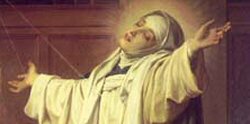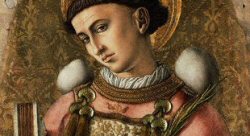 Traditional Benedictines Flourish in Eastern Oklahoma
Traditional Benedictines Flourish in Eastern OklahomaFrom Zenit
By Jason Adkins
HULBERT, Oklahoma, JUNE 12, 2008 (Zenit.org).- It’s been said that when the revolution comes, you won’t read about it in the newspapers.
Indeed, when the history of this part of the world is written, it may point to the recent establishment of a monastery amid the rolling hills and lakes of eastern Oklahoma as an event of momentous consequence for fostering a renaissance of Christian culture.
On my return drive to Minnesota after living for a year in Texas, I chose to spend some time at Our Lady of the Annunciation of Clear Creek monastery where an order of Benedictine monks, known as the “Clear Creek monks,” is attempting to rebuild monastic life and Christian culture in America from the ground up -- literally.
There, along with sharing in the common life of the monks, I spoke to the monastery’s prior, Father Philip Anderson, about the history and mission of this new monastic community.
Foundation
Father Anderson told me the Clear Creek monks’ story begins at the University of Kansas. There, a Great Books program, funded by the National Endowment for the Humanities, gave students the opportunity to encounter the culture and ideas of Western Civilization.
This program run by John Senior was not a relativistic one -- allowing students to pick and choose among various philosophical viewpoints -- as is common among programs of that type.
Rather, the success of the program resulted from Senior’s willingness to propose answers to the deepest questions, and point to Catholicism as the source of the many fruits the West has produced. Senior also stressed the importance of the Latin language as the medium through which this common civilization and its achievements were bound together.
According to Father Anderson, the program became wildly popular and produced not a few converts to the faith; then some prominent university donors protested and the program was shut down. But Senior spawned a small movement among students that did not end with the closure of the great books program.
When some students, one of whom was Father Anderson, approached Senior about how to rebuild a civilization being lost to modern technocratic society, Senior suggested the students go find some monks in Europe -- for there were few, if any, left in America -- who were living a traditional monastic life.
The journey eventually led Father Anderson and his companions to the medieval French Benedictine Abbey of Fontgombault, where they were welcomed and received formation in the religious life according to the Rule of St. Benedict. All along, these monks intended to return to America to establish a new monastery on their native soil.
The wait would last almost 25 years, concluding in 1998 when Bishop Edward Slattery of Tulsa invited the monks from Fontgombault to form a foundation community of that abbey in his diocese.
According to Father Anderson, building the monastery in eastern Oklahoma was the result of a fortuitous combination of an enthusiastic bishop, a Midwestern location -- close to many of Senior’s original students who could contribute to the foundation -- and the right piece of property. Father Anderson described the rocky property as “perfect for the monastic life.”
Since 1999, the original American monks, along with some Canadian and French brethren, have lived at the Clear Creek site near Hulbert, Oklahoma, where they have slowly -- but quickly, in monastic terms -- been building a monastery.
Marking the Hours
The Clear Creek monastic life centers on liturgical prayer, particularly the Liturgy of the Hours, which the monks chant in Latin eight times a day. The monk’s life, says Father Anderson, is a life of prayer: “God exists, and we have been created for him.” Praying the hours as a community allows the monks to give constant praise and thanks to the living, creator God.
The monks use the traditional -- or extraordinary -- form of the Roman liturgy. Father Anderson told me that the monks believe the traditional liturgy is more suited to the type of traditional, contemplative monastic life they wish to live. It is a symbol and embodiment, he said, of the type of cultural and religious life the monks desire to preserve.
I asked Father Anderson how the monks financially support their quiet life of prayer and praise. He said that unlike some monastic orders that make only one product and often have to build an adjoining factory to mass produce their goods, the Clear Creek monks engage in a variety of tasks and trades. The monks earn their living by raising sheep, running an orchard and vegetable farm, and making cheese, clothes and furniture.
Because the monks can perform many of the tasks needed to run the monastery, operational costs are pretty low. But building a Romanesque church for their monastery, which will be able to last a thousand years, is another matter.
"Per omnia saecula saeculorum"
The Clear Creek monks are raising money to build their church -- one they hope remains a landmark on the Oklahoma landscape for ages to come.
The monks believe their new church will be a sign of contradiction in a consumerist culture where everything is transient or can be thrown away when no longer useful. Change seems to be the only constant. The destabilizing elements in our culture are “poison for the soul” Father Anderson said.
The monks believe that people will always need faith and a culture that derives from that faith. According to the monks’ informational pamphlet, people “need a place in which they can reconnect with creation and with the silent center of their own being where God awaits them. The monastery is such a place.”
“The church will represent something permanent,” Father Anderson continued. “Architecture can have a spiritual effect on people. We hope to build something beautiful that will give value to this region and the people can be proud of.”
Father Anderson hopes construction on the church can begin sometime in 2009.
I asked Father Anderson whether the Clear Creek monks desired to rebuild civilization in America. He laughed and said that the Benedictines had “built Europe without even trying.”
“We focus on prayer,” he said. “We can only see the effects of our life indirectly like we see the ripples from a drop in a pond.”
According to Father Anderson, the work of the monks operates like concentric circles. Everything is centered on the interior life. But that has an effect on everything else, particularly the work of the monks. And the monastic way of life fosters a more contemplative way of being -- a life that explores the important questions and expresses itself through art, music festivals and literature -- that is, true culture.
Already, people have moved close to the monastery to share in the life of the monks, just like in the Middle Ages. Many laity and families show up at all times of day for Mass and to pray the hours with the monks.
Father Anderson said the diocese hopes to erect a parish nearby to assist in serving the spiritual needs of these many newcomers.
The Clear Creek monks already number 30, with three or four more expected to enter this year. The new residence they built is already filled to capacity and new monks will have to be housed in sheds adjacent to the monastery.
Father Anderson believes that the Clear Creek monks’ focus on the traditional monastic activities of prayer and manual labor, rather than following the path that many monasteries took by limiting their liturgical life in order to focus on running schools, is the secret of the monks’ vocational success.
As he said, “the life of a monk, hands folded in prayer, is a sermon without words.”
Hopefully, the story of the Clear Creek monks will inspire not only a renaissance in monastic life in the United States, but inspire teachers to be like John Senior and educate their students in truth, beauty, and goodness -- even at great professional cost.
With more teachers like Senior, and monks like those at Clear Creek, the possibility of the renewal of authentic monastic and Christian cultural life in America looks brighter.
























No comments:
Post a Comment